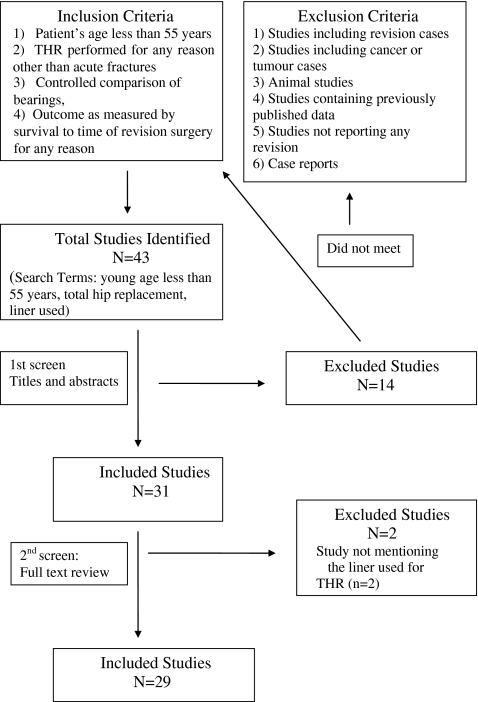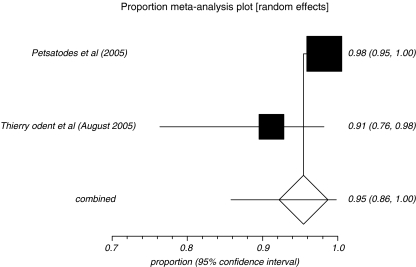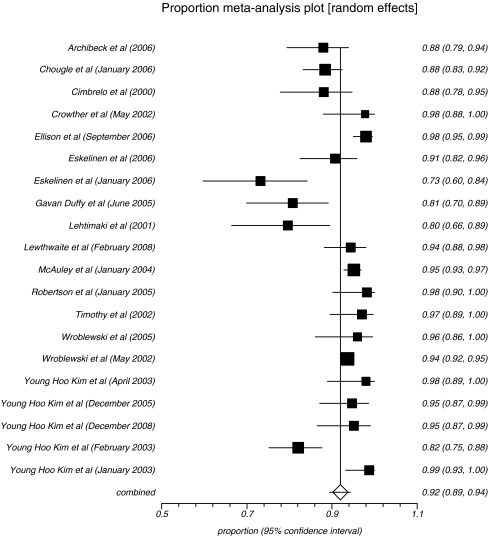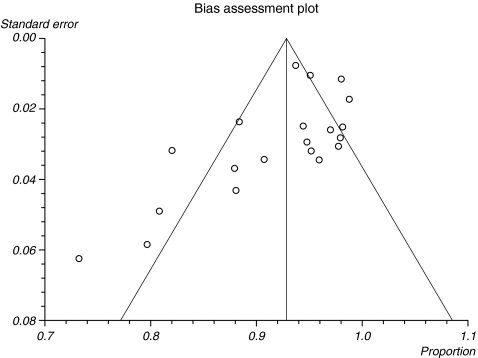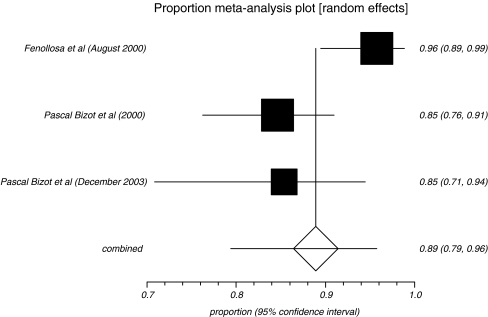Abstract
Although there is general consensus about the efficacy of total hip replacement (THR) in young patients, the most appropriate bearings in young patients remain highly debated. The three most popular bearings in use include metal-on-polyethylene (MOP), metal-on-metal (MOM) and ceramic-on-ceramic (COC). We conducted a systematic review and meta-analysis of literature to summarise the best available evidence on relative success of the three most popular bearings used in THR in young active patients. Our findings support the use of MOM bearings in the management of the young arthritic hip. These findings, largely based upon observational studies, should be taken in the context of the limitations of such non-randomised study designs.
Introduction
Total hip replacement (THR) is one of the most successful procedures for surgical treatment of advanced hip arthritis. Although prosthetic replacement of the hip in young patients has been now accepted as one of the most rewarding surgical procedures, there is considerable debate regarding the type of bearings in THR in this group of patients. The three most popular bearings in use include metal-on-polyethylene (MOP), metal-on-metal (MOM) and ceramic-on-ceramic (COC). Because younger patients are more likely to place increased demands on a replacement and have a longer life expectancy, bearing surface wear and osteolysis become more serious problems in this active population. Many reports have shown inferior results for replacement in younger patients compared to the general THR population [1, 2]. It is now well accepted that youth and high activity levels are among the factors that increase the risk of wear debris and subsequent mechanical failure of a total hip prosthesis [3]. Therefore, the use of material with low wear debris production, including MOM articulation and COC articulation, has become an attractive alternative in these patients with a high activity level [3–6]. It has been reported that MOM and COC hip prostheses have the potential to produce less wear and therefore a reduced reaction to wear debris [3].
In order to answer the most common question—which bearing has to be used in the young arthritic hip?—we conducted a systematic review of literature and a meta-analysis to summarise the best available evidence on the relative success of the three most popular bearings used in THR in young active patients.
Methods
Search strategy
Two investigators systematically searched through MEDLINE (October 1975 –December 2008) to identify and retrieve relevant studies published in the English language. The following search terms were used: (1) total hip replacement*, (2) young hip arthritis*, (3) bearings in total hip replacement*. The asterisks (*) were used to improve the sensitivity of our search strategy (Fig. 1).
Fig. 1.
Search strategy and screening
Selection criteria
Eligibility criteria included the following: (1) THR performed in young patients with mean age less than 55 years of age, (2) THR performed for any reason other than acute fractures, (3) controlled comparison of bearings, and (4) outcome as measured by survival to time of revision surgery for any reason. Exclusion criteria included: (1) studies that included revision cases, (2) studies including cancer or tumour cases, (3) animal studies, (4) studies containing previously published data, (5) studies that did not report any revision events, and (6) case reports.
Assessment of study quality
Initial screening of articles was performed by two investigators. Two more investigators then independently assessed each of the studies for eligibility for inclusion. If the title or the abstract was judged by either investigator to be potentially eligible, the full article was examined. The investigators obtained consensus, with any discrepancies, by discussion or through the input of a third investigator.
Data extraction and synthesis
Data were extracted by one of the investigators and checked for accuracy by a second. Information retrieved from each study included study design, number of participants, bearings used, study setting, statistical methods employed, patient characteristics, sample size, follow-up duration, survivorship estimates and potential sources of conflict of interest. The original plan was to look at the survivorship at ten, 15, 20 and 25 years. However, many of the studies we considered did not provide adequate information on survivorship beyond ten years. Therefore, we restricted the survivorship analysis for the three important bearings to ten years.
Statistical analysis
For the purpose of meta-analysis, proportions were first transformed into a quantity based upon the Freeman-Tukey variant of the arcsine square root transformed proportion [7] suitable for the usual fixed and random effects summaries [8]. All the selected studies were divided into three groups according to the bearings used as (a) MOP, (b) MOM, and (c) COC. Meta-analysis was done for the overall group and for each of these subgroups for survivorship estimates (10, 15, 20 and 25 years). The pooled proportion is calculated as the back-transform of the weighted mean of the transformed proportions, using inverse arcsine variance weights for the fixed effects model and DerSimonian-Laird [8] weights for the random effects model. We examined heterogeneity using both the Cochran chi-square test (Cochran Q) and the I2 statistic. Cochran Q is associated with a heterogeneity p value, and values of <0.10 suggest that there is sufficient heterogeneity of treatment effects to preclude meaningful pooling of trials. I2 represents the percentage of between-study variability that is due to true differences between studies (heterogeneity) rather than to sampling error (chance). We considered an I2 value of >50% to reflect substantial heterogeneity. We found the differences between studies large, so we followed a random effects model.
Potential for publication bias was evaluated with the use of Egger’s test for funnel plot asymmetry [9] and Harbord-Egger test [10]. All analyses were performed using Stats Direct 2.7.2 and SPSS 15 (SPSS Inc., Chicago, IL, USA).
Results
We identified a total of 43 studies, of which 31 met our inclusion criteria after initial screening of the titles and abstracts. Of these 31 studies, 29 met the criteria for final review (Fig. 1). Two studies were excluded due to lack of information about liner used during the procedure.
Study characteristics
All 29 studies were observational studies. Details of the studies are shown in Table 1. Studies ranged in sample size from 34 to 1,092 with mean patient ages ranging from 18.3 to 55.4. Studies provided mean follow-up ranging from 39 to 259 months.
Table 1.
Study characteristics
| Study number | Investigator | Number of patients | Bearing | Mean age, years | Mean FU, months | Patients surviving at 10 years |
|---|---|---|---|---|---|---|
| 1 | Archibeck et al. (2006) | 91 | Metal-on-poly | 39.00 | 108.00 | 80 |
| 2 | Joshi et al. (July 1993) | 141 | Metal-on-poly | 32.00 | 192.00 | - |
| 3 | Chougle et al. (January 2006) | 206 | Metal-on-poly | 42.60 | 187.00 | 182 |
| 4 | Cimbrelo et al. (2000) | 67 | Metal-on-poly | 32.40 | 259.00 | 59 |
| 5 | Crowther et al. (May 2002) | 44 | Metal-on-poly | 37.00 | 132.00 | 43 |
| 6 | Ellison et al. (September 2006) | 201 | Metal-on-poly | 34.70 | 91.00 | 197 |
| 7 | Eskelinen et al. (2006) | 86 | Metal-on-poly | 39.50 | 77 | |
| 8 | Eskelinen et al. (January 2006) | 56 | Metal-on-poly | 54.00 | 39.00 | 41 |
| 9 | Fenollosa et al. (August 2000) | 94 | Ceramic-on-ceramic | 38.10 | 111.60 | 90 |
| 10 | Duffy et al. (June 2005) | 73 | Metal-on-poly | 38.00 | 120.00 | 59 |
| 11 | Hartofilakidis et al. (February 2004) | 168 | Metal-on-poly | 53.00 | 62.00 | - |
| 12 | Lehtimaki et al. (2001) | 54 | Metal-on-poly | 40.00 | 240.00 | 43 |
| 13 | Lewthwaite et al. (February 2008) | 107 | Metal-on-poly | 42.00 | 149.00 | 101 |
| 14 | McAuley et al. (January 2004) | 488 | Metal-on-poly | 40.00 | 81.20 | 464 |
| 15 | Nercessian et al. (2001) | 52 | Metal-on-poly | 48.30 | 125.00 | - |
| 16 | Reigstad et al. (2008) | 70 | Metal-on-poly | 52.00 | 192.00 | - |
| 17 | Bizot et al. (2000) | 104 | Ceramic-on-ceramic | 33.20 | 91.00 | 88 |
| 18 | Bizot et al. (December 2003) | 41 | Ceramic-on-ceramic | 41.00 | 55.00 | 35 |
| 19 | Petsatodes et al. (2005) | 220 | Metal-on-metal | 47.50 | 161.00 | 216 |
| 20 | Robertson et al. (January 2005) | 54 | Metal-on-poly | 48.00 | 104.00 | 53 |
| 21 | Odent et al. (August 2005) | 34 | Metal-on-metal | 18.30 | 72.00 | 31 |
| 22 | Timothy et al. (2002) | 66 | Metal-on-poly | 55.40 | 44.00 | 64 |
| 23 | Wroblewski et al. (2005) | 49 | Metal-on-poly | 37.00 | 160.00 | 46 |
| 24 | Wroblewski et al. (May 2002) | 1092 | Metal-on-poly | 41.00 | 181.00 | 1023 |
| 25 | Kim et al. (April 2003) | 48 | Metal-on-poly | 47.90 | 84.00 | 47 |
| 26 | Kim et al. (December 2005) | 76 | Metal-on-poly | 49.50 | 115.00 | 72 |
| 27 | Kim et al. (December 2008) | 62 | Metal-on-poly | 47.50 | 182.00 | 59 |
| 28 | Kim et al. (February 2003) | 161 | Metal-on-poly | 41.90 | 116.00 | 132 |
| 29 | Kim et al. (January 2003) | 80 | Metal-on-poly | 46.80 | 114.00 | 79 |
Comparison of alternative bearings
Table 2 summaries the bearings used in these studies and their survival at ten years.
Table 2.
Results of meta-analysis: survival rate – random effects (DerSimonian-Laird) [8]
| Characteristic | Bearings | ||
|---|---|---|---|
| Metal-on-poly (MOP) | Metal-on-metal (MOM) | Ceramic-on-ceramic (COC) | |
| Total number of patients analysed | 3,592 | 239 | 254 |
| Sample range | 44–1,092 | 34–220 | 41–104 |
| Mean age in years | 43.313 | 32.900 | 37.433 |
| Mean follow-up in months | 133.791 | 116.500 | 85.867 |
| Survival rate at ten years | 91.99% (95% CI 89.41–94.24%) | 95.44% (95% CI 85.79–99.80%) | 88.90% (95% CI 79.38–95.74%) |
CI confidence interval
Ten-year survival rates suggest that MOM bearings performed significantly better than MOP (p = 0.01) and COC (p = 0.001). MOP revealed higher survival rates than COC (p = 0.05). However, after adjusting for multiple comparisons, this difference no longer achieved conventional thresholds of statistical significance.
MOM (two studies, sample size of 239 patients) in patients with mean age less than 55 years achieved a pooled ten-year survival of 95.4% (95% CI 85.8–99.8%). Figure 2 shows the proportion meta-analysis plot (random effects) for the MOM group at the end of ten years. Bias indicators were uninformative due to the small number of studies.
Fig. 2.
The proportion meta-analysis plot (random effects) for the metal-on-metal (MOM) group at the end of ten years
In comparison, THRs with MOP liners (20 studies, sample size of 3,592 patients) achieved pooled ten-year survival rates of 92.0% (95% CI 89.4–94.2%, I2 = 80.8%). Figure 3 shows the proportion meta-analysis plot (random effects) for the MOP group at the end of ten years. Publication bias was not apparent (Egger bias = −1.56 and p = 0.06; Harbord-Egger bias = −1.26 and p = 0.3) (Fig. 4).
Fig. 3.
The proportion meta-analysis plot (random effects) for the metal-on-poly (MOP) group at the end of ten years
Fig. 4.
The bias assessment plot for the metal-on-poly (MOP) bearings group at the end of ten years
COC bearing surfaces (three studies, sample size of 254 patients) revealed the lowest ten-year survival rates of 88.9% (95% CI 79.4–95.7%, I2 = 75). The proportion meta-analysis plot (random effects) for the COC liner group at the end of ten years is shown in Fig. 5. The analysis of publication bias did not reveal any significant bias (Harbord-Egger bias = −1.76 and p = 0.86). Funnel plots were uninformative due to the small number of studies pooled.
Fig. 5.
The proportion meta-analysis plot (random effects) for the ceramic-on-ceramic (COC) bearings group at the end of ten years
Discussion
There is no doubt that THR has stood the test of time in the elderly age group. Today, THR remains one of the most successful orthopaedic interventions even in young, active individuals. Although there have been significant technological advances in materials used in THR, there is still much debate about the appropriate bearings, particularly in young individuals. Younger patients are expected to place increased demands on THRs, not only because they are more active, but also because they have a longer life expectancy. When a THR is considered for a patient in this age group, the choice of bearing surface can be confusing to a surgeon [3]. Three of the most popular bearings used in young patients are MOP, MOM and COC.
Although MOP bearings have shown good long-term results with the Charnley prosthesis, radiological aseptic loosening rates were high with these bearings [3]. This has been related to the response to particulate debris generated by wear of the ultrahigh molecular weight polyethylene of the acetabular component, subsequent osteolysis and mechanical failure. Wangen et al. [2] have shown that the prevalence of osteolysis in uncemented prostheses has been reported to vary between 40% and 50% and even up to 60% in the younger age groups. Because of this, there is a need to consider bearings made of materials that result in less wear [11–13].
Yong-Chan et al. [5] noted that MOM and COC articulations have the lowest wear rate among various bearings. Ceramic particles induced less macrophage reaction and decreased cytokine secretion compared to particles of high-density polyethylene [5, 14]. As a result of the improved survival of uncemented THR components using these alternative bearings, their use has increased despite the higher costs [15]. Use of COC bearings became very popular in the 1990s as it was meant to reduce the wear [3]. Retrieved specimens of COC bearings showed minimal wear of the alumina components as shown by Dorlot et al. [4]. The incidence of osteolysis was also found to be low. However, problems have been reported with both MOM and COC bearings. Kim et al. [11] showed definite femoral osteolysis associated with the MOM; histological examination of the tissue showed multiple lymphocytes with a perivascular distribution and a small number of macrophages, suggesting that the cause of the osteolysis was hypersensitivity-induced vasculitis rather than a particle-induced reaction [11, 12]. The risk of ceramic fracture is a well-recognised problem. Ceramic fractures of a contemporary COC articulation reported in a recent study were 1% [5]. Following improvements in manufacturing technology, the fracture rate has reduced from approximately 1 in 2,000 to 1 in 10,000 implants. Nevertheless, ceramic fracture is still a major concern for modern COC hip bearings [1, 16]. In spite of the tribological evolution of ceramics, a number of concerns still remain: the potential for ceramic fracture, fewer intra-operative modular component options, micro separation, impingement noise issues, and the potential for problems when a new head is placed on an old trunion during revision [16].
In this study, we could not look at survivor statistics beyond ten years in all major bearings. Survivorship at ten years was available for all three groups in all the articles studied. Therefore, we restricted the analysis to ten years. Our study has shown that THRs using MOM bearings have the highest survival rate of 95.4% with 95% confidence interval of 85.8–99.8% compared to 92.0% for THRs using the MOP bearing and 88.9% for THRs using the COC bearing.
The strength of our study is that it is one of the first of its kind. Observational meta-analysis is rare as meta-analysis is usually carried out for experimental studies. However, this study also has some limitations as only three groups were studied, and there were small sample sizes in the MOM- and COC-bearings groups, which makes statistical analysis weak. The imbalance in the numbers between the three groups may be another weakness of this study.
Conclusion
Our study supports the use of a MOM articulation in young active patients. At the end of ten years, the MOM bearing shows maximum survival rate and superiority compared to MOP and COC bearings. These findings, largely based upon observational studies, should be taken in the context of the limitations of such non-randomised study designs.
Acknowledgments
Conflict of interest The authors declare that they have no conflict of interest.
References
- 1.Yoo JJ, Kim YM, Yoon KS, Koo KH, Kim JW, Nam KW, Kim HJ. Contemporary alumina on alumina total hip replacement. J Biomed Mater Res B Appl Biomater. 2006;78B:70–75. doi: 10.1002/jbm.b.30457. [DOI] [PubMed] [Google Scholar]
- 2.Wangen H, Lereim P, Holm I, Gunderson R, Reikeras O. Hip replacement in patients younger than 30 years: excellent ten to 16-year follow-up results with a HA-coated stem. Int Orthop. 2008;32(2):203–208. doi: 10.1007/s00264-006-0309-2. [DOI] [PMC free article] [PubMed] [Google Scholar]
- 3.Bizot P, Banallec L, Sedel L, Nizard R. Alumina-on-alumina total hip prostheses in patients 40 years of age or younger. Clin Orthop Relat Res. 2000;379:68–76. doi: 10.1097/00003086-200010000-00010. [DOI] [PubMed] [Google Scholar]
- 4.Nich C, Sari Ali EH, Hannouche D, Nizard R, Witvoet J, Sedel L, Dorlot M, Bizot P. Long-term results of alumina-on-alumina hip replacement for osteonecrosis. Clin Orthop Relat Res. 2003;417:102–111. doi: 10.1097/01.blo.0000096820.67494.bf. [DOI] [PubMed] [Google Scholar]
- 5.Chan HY, Koo KH, Jeong ST, Yoo JJ, Kim YM, Kim HJ. Cementless alumina-on-alumina total hip replacement in patients younger than 50 years—a 5-year minimum follow-up study. J Arthroplasty. 2007;22:184–188. doi: 10.1016/j.arth.2006.02.169. [DOI] [PubMed] [Google Scholar]
- 6.Robertson A, Lavalette D, Morgan S, Angus PD. The hydroxyapatite-coated JRI-furlong hip outcome in patients under the age of 55 years. J Bone Joint Surg Br. 2005;87:12–15. [PubMed] [Google Scholar]
- 7.Stuart A, Ord JK. Kendall's advanced theory of statistics. 6. London: Edward Arnold; 1994. [Google Scholar]
- 8.DerSimonian R, Laird N. Meta-analysis in clinical trials. Control Clin Trials. 1986;7(3):177–188. doi: 10.1016/0197-2456(86)90046-2. [DOI] [PubMed] [Google Scholar]
- 9.Egger M (1997) Bias in meta-analysis detected by a simple, graphical test. BMJ 13;315(7109):629–634 [DOI] [PMC free article] [PubMed]
- 10.Harbord RM, Egger M, Sterne JAC. A modified test for small-study effects in meta-analyses of controlled trials with binary endpoints. Stat Med. 2006;25(20):3443–3457. doi: 10.1002/sim.2380. [DOI] [PubMed] [Google Scholar]
- 11.Kim SY, Kyung HS, Chulihn J, Cho MR, Hoikoo K, Kim CY. Cementless metasul metal-on-metal total hip replacement in patients. J Bone Joint Surg Am. 2004;86:2475–2481. doi: 10.1302/0301-620X.86B7.15255. [DOI] [PubMed] [Google Scholar]
- 12.Eskelinenl A, Remes V, Helenius I, Pulkkinen P, Nevalainen J, Paavolainen P. Uncemented total hip replacement for primary osteoarthritis in young patients. A mid- to long-term follow-up study from the Finnish Replacement Register. Acta Orthop. 2006;77(1):57–70. doi: 10.1080/17453670610045704. [DOI] [PubMed] [Google Scholar]
- 13.Kim SY, Kyung HS, Chulihn J, Cho MR, Hoikoo K, Kim CY. Cementless alumina-on-alumina total hip replacement in patients younger than 50 years: a 5-year minimum follow-up study. J Arthroplasty. 2007;22(2):184–188. doi: 10.1016/j.arth.2006.12.090. [DOI] [PubMed] [Google Scholar]
- 14.Archibeck MJ, Surdam JW, Schultz SC, Jr, Junick DW, White RE. Cementless total hip replacement in patients 50 years or younger. J Arthroplasty. 2006;21(4):476–483. doi: 10.1016/j.arth.2005.08.011. [DOI] [PubMed] [Google Scholar]
- 15.Morshed S, Bozic KJ, Ries MD, Malchau H, Colford JM., Jr Comparison of cemented and uncemented fixation in total hip replacement: a meta-analysis. Acta Orthop. 2007;78(3):315–326. doi: 10.1080/17453670710013861. [DOI] [PubMed] [Google Scholar]
- 16.Baek SH, Kim SY. Cementless total hip replacement with alumina bearings in patients younger than fifty with femoral head osteonecrosis. J Bone Joint Surg Am. 2008;90(6):1314–1320. doi: 10.2106/JBJS.G.00755. [DOI] [PubMed] [Google Scholar]



